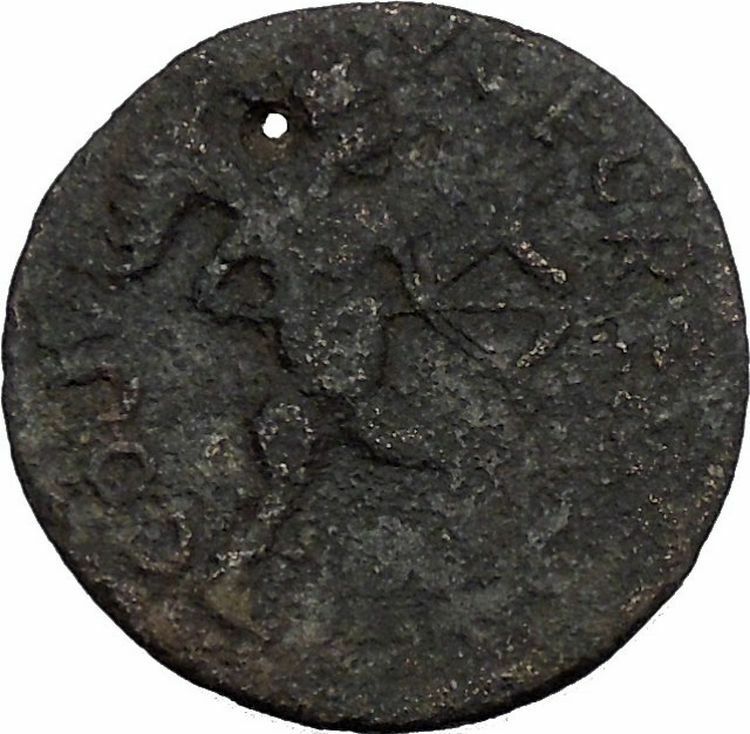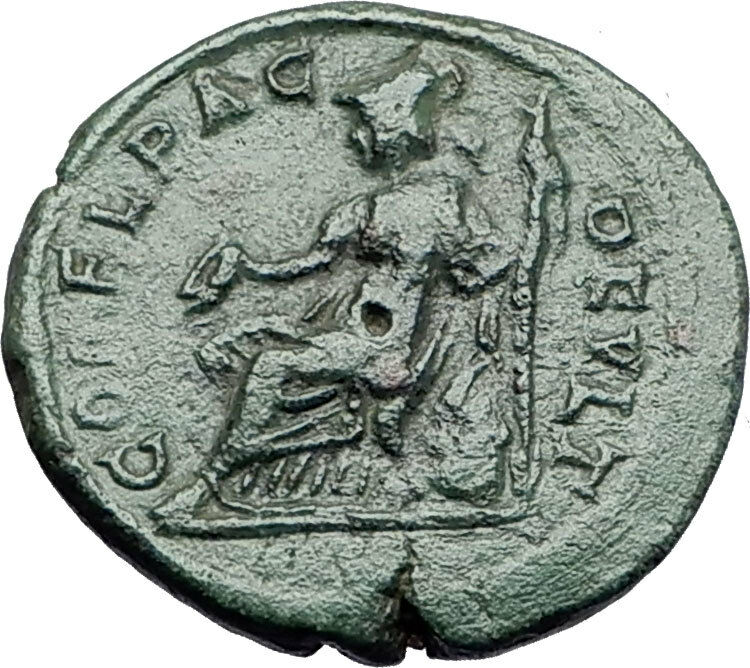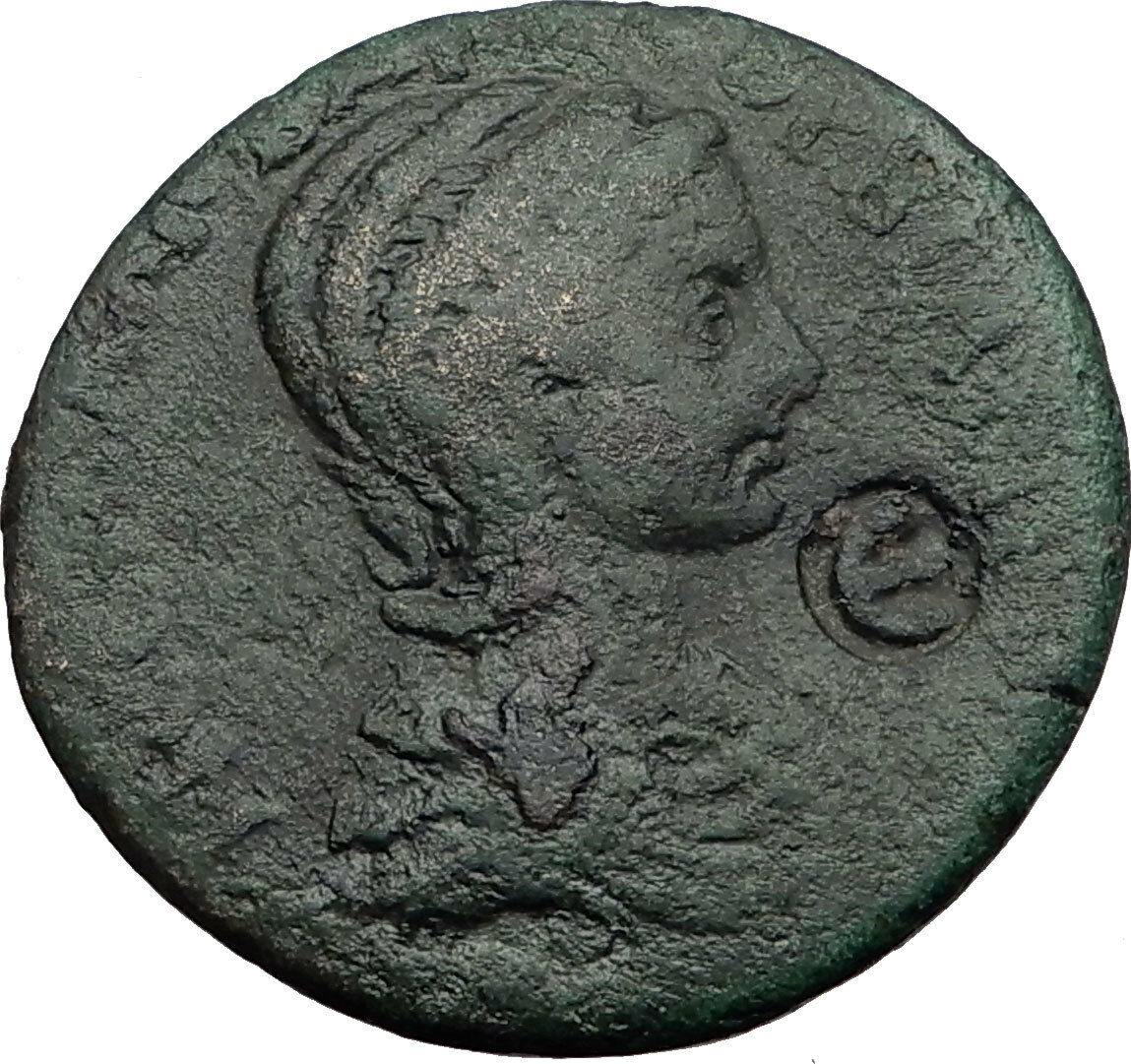|
Gallienus
–
Roman Emperor
: 253-268 A.D. –
Bronze 29mm (21.79 grams) of
Side
in
Pamphylia
AVT. KAI. ΠΟV. ΛΙ. ЄΓΝΑ. ΓΑΛΛΛΙΗΝΟC CЄ., Laureate,
draped and cuirassed bust right; I in field to right; dotted border.
CΙΔΗΤΩΝ ΝЄΩΚΟΡΩΝ, emperor standing left, holding long sceptre and patera.
This coin celebrates the city’s neocorate status.
You are bidding on the exact item pictured,
provided with a Certificate of Authenticity and Lifetime Guarantee of
Authenticity.
Neocorate
Status of a City, an Honor Bestowed
by the
Emperor
– Neocorus is the Greek name for
the person that was in charge of taking care of a temple. The Roman had many
Greek cities under their control and taxation. So what these cities had was a
cult of worship of the emperor and the empire, so this name was then given to
the specific cities that maintained this cult worship. Getting this status, was
meant to show allegiance to the emperor and the empire. The cities has to earn
the status from the emperor to bestow it upon them. There may have been
additional benefits associated with this status also. The cities were very
honored to announce the status on their coins, bearing the Greek NEΩKOPΩN on
them. There were many times that neocorate status was award many times, so
subsequent statuses would be signaled with various Greek letters, preceding the
NEΩKOPΩN inscription such as B,Δ,Γ. A city
which got this status, would have agonistic, or (Olympic-type) athletic contest
type games and festivals. So there are many coins that depict agonistic imagery
on them struck in honor of these events. Not many people in ancient numismatics
understand or know about the significance of these honors bestowed on a city.
This furnishes a great record for study to unravel the mysteries of the ancient
past and a connection between the government of the city and the various gods
and goddesses depicted on them.
Side (Greek:
Σίδη Side,
Turkish
: Side)
was an ancient Greek city in
Anatolia
, in the region of
Pamphylia
, in what is now
Antalya province
, on the southern Mediterranean
coast of Turkey
. It is now a resort town and one of the
best-known classical sites in
Turkey
, near
Manavgat
and the village of
Selimiye
, 75 km from
Antalya
) in the
province of Antalya
.
It is located on the eastern part of the
Pamphylian
coast, which lies about 20 km east
of the mouth of the
Eurymedon River
. Today, as in antiquity, the
ancient city is situated on a small north-south
peninsula
about 1 km long and 400 m across.
History
Strabo
and
Arrian
both record that Side was founded by
Greek
settlers from
Cyme
in
Aeolis
, a region of western
Anatolia
. This most likely occurred in the
seventh century B.C. Possessing a good harbor for small-craft boats, Side’s
natural geography made it one of the most important places in
Pamphylia
and one of the most important trade
centers in the region. According to
Arrian
, when settlers from Cyme came to Side,
they could not understand the dialect. After a short while, the influence of
this indigenous tongue was so great that the newcomers forgot their native Greek
and started using the language of Side. Excavations have revealed several
inscriptions written in this language. The inscriptions, dating from the third
and second centuries B.C., remain undeciphered, but testify that the local
language was still in use several centuries after colonization. Another object
found in the excavations at Side, a basalt column base from the seventh century
B.C. and attributable to the
Neo-Hittites
, provides further evidence of the
site’s early history. The name Side is Anatolian in origin and means
pomegranate
.
Next to no information exists concerning Side under
Lydian
and
Persian
sovereignty.
Alexander
the Great
Alexander the Great
occupied Side without a
struggle in 333 BC. Alexander left only a single garrison behind to occupy the
city. This occupation, in turn, introduced the people of Side to
Hellenistic
culture, which flourished from the
fourth to the first century BC. After Alexander’s death, Side fell under the
control of one of Alexander’s generals,
Ptolemy I Soter
, who declared himself king of
Egypt
in 305 BC. The
Ptolemaic dynasty
controlled Side until it was
captured by the
Seleucid Empire
in the second century BC. Yet,
despite these occupations, Side managed to preserve some autonomy, grew
prosperous, and became an important cultural center.
In 190 BC a fleet from the Greek island
city-state
of
Rhodes
, supported by
Rome
and
Pergamum
, defeated the Seleucid King
Antiochus the Great
‘s fleet, which was under
the command of the fugitive
Carthaginian
general
Hannibal
. The defeat of Hannibal and Antiochus
the Great meant that Side freed itself from the overlordship of the
Seleucid Empire
. The
Treaty of Apamea
(188 BC) forced Antiochus to
abandon all European territories and to cede all of Asia Minor north of the
Taurus Mountains to
Pergamum
. However, the dominion of Pergamum
only reached de facto as far as
Perga
, leaving Eastern
Pamphylia
in a state of uncertain freedom. This
led
Attalus II Philadelphus
to construct a new
harbour in the city of
Attalia
(the present Antalya), although Side
already possessed an important harbour of its own. Between 188 and 36 BC Side
minted its own money,
tetradrachms
showing
Nike
and a laurel wreath (the sign of victory).
In the first century BC, Side reached a peak when the Cilician
pirates
established their chief naval base and
a centre for their
slave-trade
.
Romans
.jpg/150px-Side.Apollo(4).jpg)
Temple of Apollo
The consul
Servilius Vatia
defeated these brigands in 78
BC and later the Roman general
Pompey
in 67 BC, bringing Side under the
control of Rome and beginning its second period of ascendancy, when it
established and maintained a good working relationship with the Roman Empire.
Emperor Augustus
reformed the state administration and
placed Pamphylia and Side in the Roman province of
Galatia
in 25 BC, after the short reign of
Amyntas of Galatia
between 36 and 25 BC. Side
began another prosperous period as a commercial center in
Asia Minor
through its trade in olive oil. Its
population grew to 60,000 inhabitants. This period would last well into the
third century AD. Side also established itself as a slave-trading center in the
Mediterranean
. Its large commercial fleet
engaged in acts of piracy, while wealthy merchants paid for such tributes as
public works, monuments, and competitions as well as the games and gladiator
fights. Most of the extant ruins at Side date from this period of prosperity.
Decline
Side began a steady decline from the fourth century on. Even defensive walls
could not stop successive invasions of highlanders from the Taurus Mountains.
During the fifth and sixth centuries, Side experienced a revival, and became the
seat of the Bishopric of Eastern Pamphylia. Arab fleets, nevertheless, raided
and burned Side during the seventh century, contributing to its decline. The
combination of earthquakes, Christian zealots and Arab raids, left the site
abandoned by the 10th century, its citizens having emigrated to nearby Antalya.
In the twelfth century, Side temporarily established itself once more as a
large city. An inscription found on the site of the former ancient city shows a
considerable
Jewish
population in early
Byzantine
times. However, Side was abandoned
again after being sacked. Its population moved to
Antalya
, and Side became known as Eski Adalia
(“Old Antalya”) and was buried.
Ruins
The great ruins are among the most notable in Asia Minor. They cover a large
promontory where a wall and a moat separate it from the mainland. During
medieval times, the wall and moat were repaired and the promontory houses a
wealth of structures.
There are colossal ruins of a theater complex, the largest of Pamphylia,
built much like a Roman
amphitheater
that relies on arches to support
the sheer verticals. The Roman style was adopted because Side lacked a
convenient hillside that could be hollowed out in the usual Greek fashion more
typical of Asia Minor. The theater is less preserved than the theater at
Aspendos
, but it is almost as large, seating
15,000 – 20,000 people. With time and the shifting of the earth, the scena
wall has collapsed over the stage and the proscenium is in a cataract of loose
blocks. It was converted into an open-air sanctuary with two chapels during
Byzantine
times (5th-6th c.)
The well-preserved city walls provide an entrance to the site through the
Hellenistic main gate (Megale Pyle) of the ancient city, although this
gate from the second century BC is badly damaged. Next comes the colonnaded
street, whose marble columns are no longer extant; all that remains are a few
broken stubs near the old Roman baths. The street leads to the a public bath,
restored as a museum displaying statues and sarcophagi from the Roman period.
Next is the square agora
with the remains of the round
Tyche
and
Fortuna
temple (2nd c. BC), a periptery with
twelve columns, in the middle. In later times it was used as a trading center
where pirates sold slaves. The remains of the theatre, which was used for
gladiator fights and later as a church, and the monumental gate date back to the
2nd century. The early Roman Temple of
Dionysus
is near the theater. The fountain
gracing the entrance is restored. At the left side are the remains of a
Byzantine Basilica. A public bath has also been restored.
The remaining ruins of Side include three temples, an aqueduct, and a
nymphaeum
. Side’s nymphaeum – a grotto with a
natural water supply dedicated to the nymphs – was an artificial grotto or
fountain building of elaborate design.
Turkish archaeologists have been excavating Side since 1947 and
intermittently continue to do so.
Today
In 1895 Greek Muslim refugees from
Crete
moved to the ruined town and called it
Selimiye. Today, Side has become a popular vacation destination and experiences
a new revival.
It was a popular spot for watching the
solar eclipse of March 29, 2006
.
Having been the Bishopric of Eastern Pamphylia, it is still a
titular see
of the
Roman Catholic church
.
Gallienus (Latin:
Publius Licinius Egnatius Gallienus Augustus;
c. 218 – 268) was
Roman Emperor
with his father
Valerian
from 253 to 260 and alone from 260 to
268. He ruled during the
Crisis of the Third Century
that nearly caused
the collapse of the empire. While he won a number of military victories, he was
unable to prevent the secession of important provinces.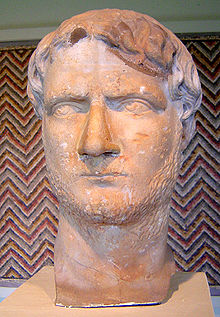
Life
Rise to power
The exact birth date of Gallienus is unknown. The Greek chronicler
John Malalas
and the Epitome de Caesaribus
report that he was about 50 years old at the time of his death, meaning he was
born around 218. He was the son of emperor
Valerian
and
Mariniana
, who may have been of senatorial
rank, possibly the daughter of
Egnatius Victor Marinianus
, and his brother was
Valerianus Minor
. Inscriptions on coins connect
him with Falerii
in
Etruria
, which may have been his birthplace; it
has yielded many inscriptions relating to his mother’s family, the Egnatii.[3]
Gallienus married
Cornelia Salonina
about ten years before his
accession to the throne. She was the mother of three princes:
Valerian II
, who died in 258;
Saloninus
, who was named co-emperor but was
murdered in 260 by the army of general Postumus; and
Marinianus
, who was killed in 268, shortly
after his father was assassinated.
When
Valerian
was proclaimed Emperor on 22 October
253, he asked the
Senate
to ratify the elevation of Gallienus to
Caesar and
Augustus
. He was also designated
Consul Ordinarius
for 254. As
Marcus Aurelius
and his adopted brother
Lucius Verus
had done a century earlier,
Gallienus and his father divided the Empire. Valerian left for the East to stem
the Persian threat, and Gallienus remained in Italy to repel the Germanic tribes
on the Rhine
and
Danube
.
Division of the empire
had become necessary due
to its sheer size and the numerous threats it faced, and it facilitated
negotiations with enemies who demanded to communicate directly with the emperor.
Early
reign and the revolt of Ingenuus
Gallienus spent most of his time in the provinces of the Rhine area (Germania
Inferior,
Germania Superior
,
Raetia
, and
Noricum
), though he almost certainly visited
the Danube
area and
Illyricum
during 253 to 258. According to
Eutropius and Aurelius Victor, he was particularly energetic and successful in
preventing invaders from attacking the German provinces and Gaul, despite the
weakness caused by Valerian’s march on Italy against
Aemilianus
in 253. According to numismatic
evidence, he seems to have won many victories there, and a victory in
Roman Dacia
might also be dated to that period.
Even the hostile Latin tradition attributes success to him at this time.
In 255 or 257, Gallienus was made Consul again, suggesting that he briefly
visited Rome on those occasions, although no record survives. During his Danube
sojourn (Drinkwater suggests in 255 or 256), he proclaimed his elder son
Valerian II
Caesar and thus official heir to
himself and Valerian I; the boy probably joined Gallienus on campaign at that
time, and when Gallienus moved west to the Rhine provinces in 257, he remained
behind on the Danube as the personification of Imperial authority.
Sometime between 258 and 260 (the exact date is unclear), while Valerian was
distracted with the ongoing invasion of Shapur in the East, and Gallienus was
preoccupied with his problems in the West,
Ingenuus
, governor of at least one of the
Pannonian provinces, took advantage and declared himself emperor. Valerian II
had apparently died on the Danube, most likely in 258. Ingenuus may have been
responsible for that calamity. Alternatively, the defeat and capture of Valerian
at the
battle of Edessa
may have been the trigger for
the subsequent revolts of Ingenuus,
Regalianus
, and
Postumus
. In any case, Gallienus reacted with
great speed. He left his son
Saloninus
as Caesar at
Cologne
, under the supervision of Albanus (or
Silvanus) and the military leadership of Postumus. He then hastily crossed the
Balkans
, taking with him the new cavalry corps
(comitatus) under the command of
Aureolus
and defeated Ingenuus at
Mursa
or
Sirmium
.The victory must be attributed mainly
to the cavalry and its brilliant commander. Ingenuus was killed by his own
guards or committed suicide by drowning himself after the fall of his capital,
Sirmium.
Invasion of the
Alamanni
A major invasion by the
Alemanni
and other Germanic tribes occurred
between 258 and 260 (it is hard to fix the precise date of these
events),probably due to the vacuum left by the withdrawal of troops supporting
Gallienus in the campaign against Ingenuus.
Franks
broke through the lower Rhine, invading
Gaul, some reaching as far as southern Spain, sacking Tarraco (modern
Tarragona
).The Alamanni invaded, probably
through
Agri Decumates
(an area between the upper Rhine
and the upper Danube), likely followed by the
Juthungi
. After devastating Germania Superior
and Raetia (parts of southern
France
and
Switzerland
), they entered Italy, the first
invasion of the Italian peninsula, aside from its most remote northern regions,
since Hannibal
500 years before. When invaders
reached the outskirts of Rome, they were repelled by an improvised army
assembled by the Senate, consisting of local troops (probably prǣtorian guards)
and the strongest of the civilian population.On their retreat through northern
Italy, they were intercepted and defeated in the
battle of Mediolanum
(near present day
Milan
) by Gallienus’ army, which had advanced
from Gaul, or from the Balkans after dealing with the Franks.The battle of
Mediolanum was decisive, and the Alamanni didn’t bother the empire for the next
ten years. The Juthungi managed to cross the Alps with their valuables and
captives from Italy. An historian in the 19th century suggested that the
initiative of the Senate gave rise to jealousy and suspicion by Gallienus, thus
contributing to his exclusion of senators from military commands.
The revolt of
Regalianus
Around the same time,
Regalianus
, a military commander of
Illyricum
, was proclaimed Emperor. The reasons
for this are unclear, and the Historia Augusta (almost the sole resource
for these events) does not provide a credible story. It is possible the seizure
can be attributed to the discontent of the civilian and military provincials,
who felt the defense of the province was being neglected.
Regalianus held power for some six months and issued coins bearing his image.
After some success against the
Sarmatians
, his revolt was put down by the
invasion of Roxolani
into
Pannonia
, and Regalianus himself was killed
when the invaders took the city of
Sirmium
. There is a suggestion that Gallienus
invited Roxolani to attack Regalianus, but other historians dismiss the
accusation.It is also suggested that the invasion was finally checked by
Gallienus near Verona
and that he directed the restoration of
the province, probably in person.
Capture of Valerian, revolt of Macrianus
In the East, Valerian was confronted with serious troubles. A band of
Scythians
set a naval raid against
Pontus
, in the northern part of modern Turkey.
After ravaging the province, they moved south into
Cappadocia
. Valerian led troops to intercept
them but failed, perhaps because of a plague that gravely weakened his army, as
well as the contemporary invasion of northern
Mesopotamia
by
Shapur I
, ruler of the
Sassanid Empire
.
In 259 or 260, the Roman army was defeated in the
Battle of Edessa
, and Valerian was taken
prisoner. Shapur’s army raided
Cilicia
and
Cappadocia
(in present day
Turkey
), sacking, as Shapur’s inscriptions
claim, 36 cities. It took a rally by an officer
Callistus
(Balista), a fiscal official named
Fulvius Macrianus
, the remains of the Eastern
Roman legions, and
Odenathus
and his
Palmyrene
horsemen to turn the tide against
Shapur. The Persians were driven back, but Macrianus proclaimed his two sons
Quietus
and
Macrianus
(sometimes misspelled Macrinus) as
emperors. Coins struck for them in major cities of the East indicate
acknowledgement of the usurpation. The two Macriani left Quietus, Ballista, and,
presumably, Odenathus to deal with the Persians while they invaded Europe with
an army of 30,000 men, according to the Historia Augusta. At first they
met no opposition. The Pannonian legions joined the invaders, being resentful of
the absence of Gallienus. He sent his successful commander Aureolus against the
rebels, however, and the decisive battle was fought in the spring or early
summer of 261, most likely in Illyricum, although
Zonaras
locates it in Pannonia. In any case,
the army of the usurpers surrendered, and their two leaders were killed.
In the aftermath of the battle, the rebellion of Postumus had already
started, so Gallienus had no time to deal with the rest of the usurpers, namely
Balista and Quietus. He came to an agreement with Odenathus, who had just
returned from his victorious Persian expedition. Odenathus received the title of
dux Romanorum and besieged the usurpers, who were based at
Emesa
. Eventually, the people of Emesa killed
Quietus, and Odenathus arrested and executed Balista about November 261.
The revolt of Postumus
After the defeat at Edessa, Gallienus lost control over the provinces of
Britain, Spain, parts of Germania, and a large part of Gaul when another
general, Postumus
, declared his own realm (usually known
today as the
Gallic Empire
). The revolt partially coincided
with that of
Macrianus
in the East. Gallienus had installed
his son Saloninus and his guardian,
Silvanus
, in Cologne in 258. Postumus, a
general in command of troops on the banks of the Rhine, defeated some raiders
and took possession of their spoils. Instead of returning it to the original
owners, he preferred to distribute it amongst his soldiers. When news of this
reached Silvanus, he demanded the spoils be sent to him. Postumus made a show of
submission, but his soldiers mutinied and proclaimed him Emperor. Under his
command, they besieged Cologne, and after some weeks the defenders of the city
opened the gates and handed Saloninus and Silvanus to Postumus, who had them
killed. The dating of these events is not accurate, but they apparently occurred
just before the end of 260. Postumus claimed the consulship for himself and one
of his associates, Honoratianus, but according to D.S. Potter, he never tried to
unseat Gallienus or invade Italy.
Upon receiving news of the murder of his son, Gallienus began gathering
forces to face Postumus. The invasion of the Macriani forced him to dispatch
Aureolus with a large force to oppose them, however, leaving him with
insufficient troops to battle Postumus. After some initial defeats, the army of
Aureolus, having defeated the Macriani, rejoined him, and Postumus was expelled.
Aureolus was entrusted with the pursuit and deliberately allowed Postumus to
escape and gather new forces. Gallienus returned in 263 or 265 and surrounded
Postumus in an unnamed Gallic city. During the siege, Gallenus was severely
wounded by an arrow and had to leave the field. The standstill persisted until
the death of Gallienus, and the
Gallic Empire
remained independent until 274.
The revolt of
Aemilianus
In 262, the mint in
Alexandria
started to again issue coins for
Gallienus, demonstrating that Egypt had returned to his control after
suppressing the revolt of the Macriani. In spring of 262, the city was wrenched
by civil unrest as a result of a new revolt. The rebel this time was the prefect
of Egypt,
Lucius Mussius Aemilianus
, who had already
given support to the revolt of the Macriani. The correspondence of bishop
Dionysius of Alexandria
provides a colourful
commentary on the sombre background of invasion, civil war, plague, and famine
that characterized this age.
Knowing he could not afford to lose control of the vital Egyptian granaries,
Gallienus sent his general Theodotus against Aemilianus, probably by a naval
expedition. The decisive battle probably took place near Thebes, and the result
was a clear defeat of Aemilianus. In the aftermath, Gallienus became Consul
three more times in 262, 264, and 266.
Herulian invasions, revolt of Aureolus, conspiracy and death
In the years 267–269, Goths and other barbarians invaded the empire in great
numbers. Sources are extremely confused on the dating of these invasions, the
participants, and their targets. Modern historians are not even able to discern
with certainty whether there were two or more of these invasions or a single
prolonged one. It seems that, at first, a major naval expedition was led by the
Heruli
starting from north of the
Black Sea
and leading in the ravaging of many
cities of Greece (among them,
Athens
and
Sparta
). Then another, even more numerous army
of invaders started a second naval invasion of the empire. The Romans defeated
the barbarians on sea first. Gallienus’ army then won a battle in
Thrace
, and the Emperor pursued the invaders.
According to some historians, he was the leader of the army who won the great
Battle of Naissus
, while the majority believes
that the victory must be attributed to his successor,
Claudius II
.
In 268, at some time before or soon after the battle of Naissus, the
authority of Gallienus was challenged by
Aureolus
, commander of the cavalry stationed in
Mediolanum
(Milan),
who was supposed to keep an eye on
Postumus
. Instead, he acted as deputy to
Postumus until the very last days of his revolt, when he seems to have claimed
the throne for himself. The decisive battle took place at what is now
Pontirolo Nuovo
near Milan; Aureolus was
clearly defeated and driven back to Milan. Gallienus laid siege to the city but
was murdered during the siege. There are differing accounts of the murder, but
the sources agree that most of Gallienus’ officials wanted him dead. According
to the
Historia Augusta
, an unreliable source compiled
long after the events it describes, a conspiracy was led by the commander of the
guard
Aurelius Heraclianus
and Marcianus.
Cecropius, commander of the Dalmatians, spread the word that the forces of
Aureolus were leaving the city, and Gallienus left his tent without his
bodyguard, only to be struck down by Cecropius.One version has Claudius selected
as Emperor by the conspirators, another chosen by Gallienus on his death bed;
the Historia Augusta was concerned to substantiate the descent of the
Constantinian dynasty
from Claudius, and this
may explain its accounts, which do not involve Claudius in the murder. The other
sources (Zosimus
i.40 and
Zonaras
xii.25) report that the conspiracy was
organized by Heraclianus, Claudius, and
Aurelian
.
According to Aurelius Victor and Zonaras, on hearing the news that Gallienus
was dead, the Senate in Rome ordered the execution of his family (including his
brother Valerianus and son Marinianus) and their supporters, just before
receiving a message from Claudius to spare their lives and deify his
predecessor.
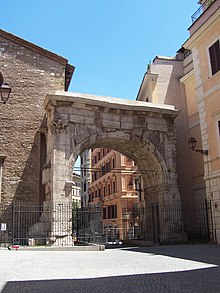
Arch of Gallienus
in Rome, 262 –
dedicated to, rather than built by, Gallienus.
Legacy
Gallienus was not treated favorably by ancient historians, partly due to the
secession of Gaul and
Palmyra
and his inability to win them back.
According to modern scholar Pat Southern, some historians now see him in a more
positive light.Gallienus produced some useful reforms. He contributed to
military history as the first to commission primarily
cavalry
units, the
Comitatenses
, that could be dispatched anywhere
in the Empire in short order. This reform arguably created a precedent for the
future emperors
Diocletian
and
Constantine I
.
The biographer
Aurelius Victor
reports that Gallienus forbade
senators
from becoming military commanders.
This policy undermined senatorial power, as more reliable
equestrian
commanders rose to prominence. In
Southern’s view, these reforms and the decline in senatorial influence not only
helped Aurelian to salvage the Empire, but they also make Gallienus one of the
emperors most responsible for the creation of the
Dominate
, along with
Septimius Severus
, Diocletian, and Constantine
I.
By portraying himself with the attributes of the gods on his coinage,
Gallienus began the final separation of the Emperor from his subjects.A late
bust of Gallienus (see above) depicts him with a largely blank face, gazing
heavenward, as seen on the famous stone head of
Constantine I
. One of the last rulers of Rome
to be theoretically called “Princeps”, or First Citizen, Gallienus’ shrewd
self-promotion assisted in paving the way for those who would be addressed with
the words “Dominus et Deus” (Lord and God).
-
Antoninianus
issued to celebrate
LEG II ITAL VII P VII F, “ItalicaLegio
II seven
times faithful and loyal.”
-
Antoninianus issued to celebrate LEG III ITAL VI P VI F,
“ItalicaLegio
III six times
faithful and loyal.”
-
Antoninianus issued to celebrate LEG VII MAC VI P VI F,
“MacedonicaLegio
VII six
times faithful and loyal.”
-
Antoninianus issued to celebrate LEG VII CLA VI P VI F,
“ClaudiaLegio
VII six
In
Roman mythology
, Providentia was the
goddess
of
forethought. Providentia. (Providence).—-With all their vices,
follies, and gross superstitions (indeed, in spite of them), the Romans still
appear to have cherished a belief in the perpetual and direct interposition of
the gods with respect to human affairs.—-Among the various monuments which
attest this religious feeling, or at leas this profession of religion, on the
part of both princes and people, none are more conspicuous than those to be
found on their imperial coins, for it is to be observed that previous to
the substitution of the monarchical for the republican form of government, that
allegorical divinity whose name is derived from providere (to foresee) is
not seen either on metal or on marble.
|




.jpg/150px-Side.Apollo(4).jpg)







